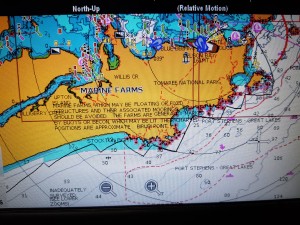We did have a couple of very good races at the Sail Port Stephens regatta and considering it is our only spinnaker regatta for the year we should be happy with the result.
The biggest winner of the regatta had to be our code zero sail and while it cost a lot in the rating department most of the time we are sailing Performance Handicapping Systems and just want to be closer to the front of the fleet. Every time we flew the code zero it we had a good result and the one time we flew the asymmetric spinnaker in lieu we had our worst result. To be fair to the spinnaker it was the first time we had flown it and we were on the wrong side of the course for the freshening wind. Still the code zero would have let us fight for clear air and point higher towards the freshening breeze. In one race we thought the asymmetric might have been better than the code zero we flew but judging by later experience that may not have worked for us.
Our weakness in the regatta was still the heavy air working to windward but I felt we made some progress. Even with a years experience we are still learning and over the post race discussions with fellow skippers and crew we picked up some more advice to try. I have already tightened the cap shrouds and put a little pre-bend into the mast. That has improved the sail shape off the mast and even when short handed on the way home we managed to handle 20 knots with the full main and No 3 jib. While I did put in a reef for comfort the full crew would have been pressing for speed records and may have done better than the 13 knots recorded as the maximum hull speed. I am not sure how accurate that is but we did see an 13.7 max speed during the regatta in lighter conditions. On both occasions we saw 10 knot briefly on the live instruments and I think a jump to 13 is probably a very short spurt down a wave.
The big yellow mast head spinnaker was certainly a winner in the light running conditions but it is a bit heavy for the dead drifts when the foot tends to droop into the water. The spinnaker snuffers worked well except when I packed the small runner incorrectly. We took that one down and put up the big mast head runner which was packed correctly and as it turned out was the correct one for the conditions. I was more comfortable using the old No 1 genoa and the full mainsail for the whole regatta even when we saw 20 knots and after seeing a mast bending demonstration on one of the competitors I now know we have been too conservative in the back stay tension area.
On the last day of racing we had a second on handicap in the Performance Cruising division 1 and an eleventh fastest overall. We started well and were fourth to the windward mark and for the first time in the regatta were matching Amanti to windward. Their crew work was too slick downwind and we were becalmed on the way home when the second last placed yacht in the fleet sailed around the hole and went on to fourth fastest. It was rewarding to be in front of so many larger yachts in that race.
After the racing on the second last day we had a violent hail storm that rained down mini golf balls denting cars in the parking lots and stripping leaves off trees. Accompanying this was a powerful gust that freed the awning from the lifelines and left the deck exposed. At first I thought we had escaped any damage but later noticed two stanchions had been bent in. A small price to pay for a most enjoyable week.
On the way home we sailed away from some of our competitors as the beam reach suited Passion X well. We just need more of these conditions. For the Newcastle to Port Stephens race we did have tight reaching conditions for the first half of the race and with the code zero flying we were making a strong showing. Once the breeze headed the fleet we had to drop the Code Zero and go into tight beating mode where the heavier boats slowly overtook us.




